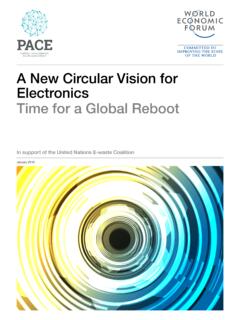Transcription of Tragedy and Hope A History of the World in Our Time
1 Tragedy and hope A History of the World in Our time By Carroll Quigley Volumes 1-8 New York: The Macmillan Company 1966 Table of Contents Introduction Preface Part One Introduction: Western Civilization In Its World Setting Chapter 1 Cultural Evolution in Civilizations Chapter 2 Cultural Diffusion in Western Civilization 2 Chapter 3 Europe's Shift to the Twentieth Century Part Two Western Civilization to 1914 Chapter 4 The Pattern of Change Chapter 5 European Economic Developments Chapter 6 The United States to 1917 Part Three The Russian Empire to 1917 Chapter 7 Creation of the Russian Civilization Part Four The Buffer Fringe Chapter 8 The Near East to 1914 Chapter 9 The British Imperial Crisis: Africa, Ireland, and India to 1926 Chapter 10 The Far East to World War I Part Five The First World War: 1914: 1918 Chapter 11 The Growth of International Tensions, 1871-1914 Chapter 12 Military History , 1914-1918 Chapter 13 Diplomatic History , 1914-1 918 Chapter 14 The Home Front, 1914-1918 Part Six The Versailles System and the Return to Normalcy: 1919-1929 Chapter 15 The Peace Settlements, 1919-1923 Chapter 16 Security, 1919-1935 Chapter 17 Disarmament, 1919-1935 Chapter 18 Reparations, 1919-1932 Part Seven Finance, Commercial and Business Activity.
2 1897-1947 Chapter 19 Reflation and Inflation, 1897-1925 Chapter 20 The Period of Stabilization, 1922-1930 Chapter 21 The Period of Deflation, 1927- 1936 Chapter 22 Reflation and Inflation, 1933-1947 Part Eight International Socialism and the Soviet Challenge Chapter 23 The International Socialist Movement Chapter 24 The Bolshevik Revolution to 1924 Chapter 25 Stalinism, 1924-1939 Part Nine Germany from Kaiser to Hitler: 1913-1945 Chapter 26 Introduction Chapter 27 The Weimar Republic, 1918-1933 Chapter 28 The Nazi Regime Part Ten Britain: the Background to Appeasement: 1900-1939 Chapter 29 The Social and Constitutional Background Chapter 30 Political History to 1939 Part Eleven Changing Economic Patterns Chapter 31 Introduction Chapter 32 Great Britain Chapter 33 Germany Chapter 34 France Chapter 35 The United States of America Chapter 36 The Economic Factors Chapter 37 The Results of Economic Depression Chapter 38 The Pluralist Economy and World Blocs Part Twelve The Policy of Appeasement, 1931-1936 Chapter 39 Introduction Chapter 40 The Japanese Assault, 1931-1941 Chapter 41 The Italian Assault, 1934-1936 Chapter 42 Circles and Counter-circles, 1935-1939 Chapter 43 The Spanish Tragedy , 1931 1939 Part Thirteen The Disruption of Europe.
3 1937-1939 Chapter 44 Austria Infelix, 1933-1938 Chapter 45 The Czechoslovak Crisis, 1937-1938 Chapter 46 The Year of Dupes, 1939 Part Fourteen World War II: the Tide of Aggression: 1939-1941 Chapter 47 Introduction Chapter 48 The Battle of Poland, September 1939 Chapter 49 The Sitzkrieg, September 1, 1939-May 1940 Chapter 50 The Fall of France, (May-June 1940) and the Vichy Regime Chapter 51 The Battle of Britain, July-October 1940 Chapter 52 The Mediterranean and Eastern Europe, 1940) June 1940-June 1941 Chapter 53 American Neutrality and Aid to Britain Chapter 54 The Nazi Attack on Soviet Russia, 1941-1942 Part Fifteen World War II: the Ebb of Aggression: 1941-1945 Chapter 55 The Rising in the Pacific, to 1942 Chapter 56 The Turning Tide, 1942-1943: Midway, E1 Alamein, French Africa, and Stalingrad Chapter 57 Closing in on Germany, 1943-1945 Chapter 58 Closing in on Japan, 1943-1945 Part Sixteen The New Age Chapter 59 Introduction Chapter 60 Rationalization and Science Chapter 61 The Twentieth-Century Pattern Part Seventeen Nuclear Rivalry and the Cold War: American Atomic Supremacy: 1945-1950 Chapter 62 The Factors Chapter 63 The Origins of the Cold War, 1945-1949 Chapter 64 The Crisis in China, 1945-1950 Chapter 65 American Confusions, 1945-1950 Part Eighteen Nuclear Rivalry and the Cold War: the Race for H-Bomb.
4 1950-1957 Chapter 66 "Joe I" and the American Nuclear Debate, 1949-1954 Chapter 67 The Korean War and Its Aftermath, 1950-1954 Chapter 68 The Eisenhower Team, 1952-1956 Chapter 69 The Rise of Khrushchev, 1953-1958 Chapter 70 The Cold War in Eastern and Southern Asia, 1950-1957 Part Nineteen The New Era: 1957-1964 Chapter 71 The Growth of Nuclear Stalemate Chapter 72 The Disintegrating Super-blocs Chapter 73 The Eclipse of Colonialism Part Twenty Tragedy and hope : the Future in Perspective Chapter 74 The Unfolding of time Chapter 75 The United States and the Middle-Class Crisis Chapter 76 European Ambiguities Chapter 77 Conclusion Introduction By Michael L. Chadwick In 1965 one of the nation's leading professors quietly finished the last draft of a 1311 page book on World History .
5 He walked over to his typewriter and secured the last pages of the book and placed them into a small box and wrapped it for mailing. He then walked to the Post Office and mailed the final draft to his publisher in New York City. The editor was somewhat overwhelmed and perhaps even inhibited by the scholarly treatise. The last thing he wanted to do was to read the huge draft. He knew and trusted the professor. After all, he was one of the leading scholars in the western World . They had been acquaintances for several years. He had already signed an agreement to publish the book before it was finished. He had read several chapters of the early draft. They were boring, at least to him. He decided to give the book to a young editor who had just been promoted to his assistant.
6 The young editor was also overwhelmed but happy to oblige the Senior Editor. The young editor was unaware of the importance of the manuscript and of the revelations which it contained. To the young editor this was just another textbook or so he thought. Somehow one of the most revealing books ever published slipped through the editorial of offices of one of the major publishing houses in New York and found it way into the bookstores of America in 1966. Five years later I was meandering through a used bookstore and stumbled upon this giant book. I picked up the book, blew the dust off and opened it to a page where the author stated that: "..[T]he powers of financial capitalism had another far-reaching aim, nothing less than to create a World system of financial control in private hands able to dominate the political system of each country and the economy of the World as a whole.
7 This system was to be controlled in a feudalist fashion by the central banks of the World acting in concert by secret agreements arrived at in frequent private meetings and conferences. The apex of the system was to be the Bank for International Settlements in Basle, Switzerland, a private bank owned and controlled by the World 's central banks which were themselves private "It must not be felt that these heads of the World 's chief central banks were themselves substantive powers in World finance. They were not. Rather, they were the technicians and agents of the dominant investment bankers of their own countries, who had raised them up and were perfectly capable of throwing them down. The substantive financial powers of the World were in the hands of these investment bankers (also called 'international' or 'merchant' bankers) who remained largely behind the scenes in their own unincorporated private banks.
8 These formed a system of international cooperation and national dominance which was more private, more powerful, and more secret than that of their agents in the central banks. this dominance of investment bankers was based on their control over the flows of credit and investment funds in their own countries and throughout the World . They could dominate the financial and industrial systems of their own countries by their influence over the flow of current funds though bank loans, the discount rate, and the re-discounting of commercial debts; they could dominate governments by their own control over current government loans and the play of the international exchanges. Almost all of this power was exercised by the personal influence and prestige of men who had demonstrated their ability in the past to bring off successful financial coupes, to keep their word, to remain cool in a crisis, and to share their winning opportunities with their associates.
9 " I could hardly believe what I was reading. I sat in the bookstore and read until closing time . I then bought the book and went home where I read almost all night. For the next twenty-five years I traveled throughout the United States, Europe and the Middle East following one lead after another to determine if the incredible words of the professor were really true. While serving as the Editor of a scholarly journal on international affairs, Director of the Center for Global Studies and foreign policy advisor for a key U. S. Senator in Washington, D. C., I conducted over 1000 interviews with influential World leaders, government officials, military generals, intelligence officers, scholars and businessmen, including corporate CEOs and prominent international bankers and investment bankers.
10 I went through over 25,000 books and over 50,000 documents. I learned for myself that the professor was telling the truth. There really is a " World system of financial control in private hands" that is "able to dominate the political system of each country and the economy of the World ." I call this system the World Trade Federation. It is an ultra-secret group of the most powerful men on the earth. They now control every major international institution, every major multinational and transnational corporation both public and private, every major domestic and international banking institution, every central bank, every nation-state on earth, the natural resources on every continent and the people around the World through complicated inter-locking networks that resemble giant spider webs.




